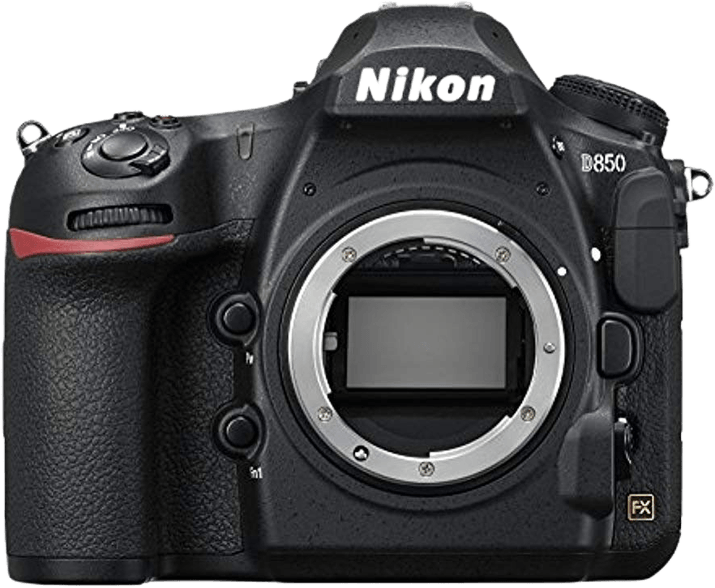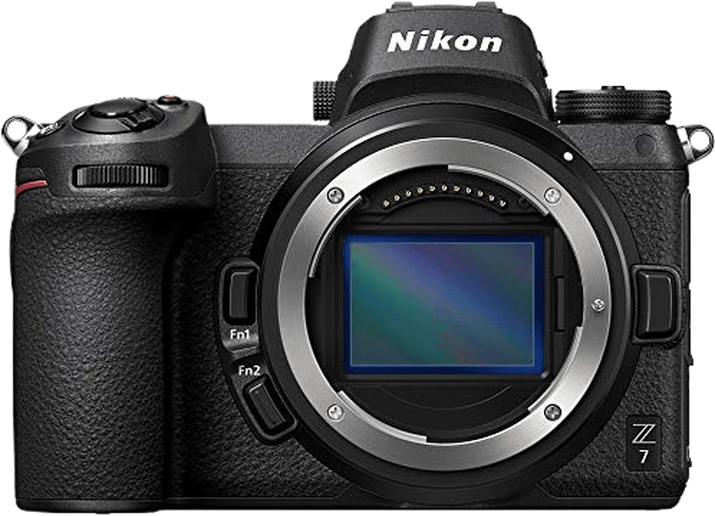Nikon D850 vs Z7 Comparison
Nikon D850

Nikon Z7

The Nikon D850 and Nikon Z7 are both top-notch cameras, each earning a score of 82/100. Both cameras were announced in August, one year apart, with the D850 in 2017 and the Z7 in 2018. They share similar launch prices, with the D850 at $3300 and the Z7 at $3400.
The Nikon D850, a DSLR camera, is larger and heavier, measuring 146 x 124 x 79mm and weighing 1005g (2.22lbs). This size and weight may be preferred by photographers who appreciate a more substantial feel.
On the other hand, the Nikon Z7 is a mirrorless camera and is more compact and lightweight, measuring 134 x 101 x 68mm and weighing 675g (1.49lbs). This makes it an ideal choice for those who prioritize portability and ease of use.
Both cameras excel in their respective categories, with the D850 offering a solid DSLR experience and the Z7 providing a more portable option without sacrificing quality. Ultimately, the choice between these two cameras comes down to personal preference in size, weight, and camera type.
Nikon D850 vs Z7 Overview and Optics
The Nikon Z7 wins the optics comparison with a score of 86/100, while the Nikon D850 scores 79/100. Both cameras share several specifications, including 45.7 megapixels, CMOS sensor type, full-frame sensor size, and the ability to shoot in RAW format. However, the Z7 outperforms the D850 in certain areas, making it the superior choice in terms of optics.
The Z7 has a faster shooting speed of 9 frames per second (fps), compared to the D850’s 7 fps. This enables the Z7 to capture fast-moving subjects with greater ease. Additionally, the Z7 features the Expeed 6 processor, an upgrade from the D850’s Expeed 5 processor. This results in better overall performance and image processing capabilities.
Furthermore, the Z7 has built-in image stabilization, which the D850 lacks. This feature allows for sharper images and smoother video capture, particularly when shooting handheld or in low light conditions. The Z7 also uses the Nikon Z lens mount, which is designed for mirrorless cameras and offers a wider range of compatible lenses.
On the other hand, the D850 has a slightly higher DXOMARK sensor score of 100, compared to the Z7’s 99. This means the D850’s sensor has a marginally better overall performance in terms of color depth, dynamic range, and low-light capabilities. However, this difference is minimal and may not be noticeable in everyday shooting situations.
Considering these factors, the Nikon Z7 is the better choice for those prioritizing optics. Its faster shooting speed, advanced processor, image stabilization, and mirrorless lens compatibility make it a more versatile option. While the D850 has a marginally higher sensor score, the Z7’s additional features outweigh this advantage.
Nikon D850 vs Z7 Video Performance
The Nikon Z7 outperforms the Nikon D850 in video capabilities, boasting a video score of 83/100 compared to the D850’s 70/100. Both cameras share some common video specifications, including a maximum video resolution of 4K and maximum video dimensions of 3840 x 2160. Additionally, they both have time-lapse functionality built in, making them suitable for capturing stunning time-lapse sequences.
The Nikon Z7’s superior video score is primarily due to its higher maximum video frame rate of 60fps, compared to the D850’s 30fps. This allows for smoother video playback and greater flexibility in post-production, such as slow-motion effects. Furthermore, the Z7’s higher frame rate ensures that fast-moving subjects are captured with more clarity and less motion blur.
The Nikon D850 does not offer any significant advantages over the Z7 in terms of video capabilities. Its lower maximum frame rate of 30fps may be sufficient for some users, but it does not provide the same level of versatility as the Z7. As a result, the D850 may be more suitable for photographers who prioritize still images over video performance.
Considering the video capabilities, the Nikon Z7 is the clear winner between the two cameras. Its higher video score, coupled with its 60fps maximum frame rate, make it a better choice for videographers and photographers who require top-notch video performance. While the Nikon D850 is still a capable camera, its video capabilities simply do not match those of the Z7.
Nikon D850 vs Z7 Features and Benefits
The Nikon D850 and Nikon Z7 both have a feature score of 87 out of 100, making them equal in this aspect. They share several specs, including a 3.2-inch screen size, touchscreen capabilities, and the absence of GPS. Both cameras also come with WIFI and Bluetooth connectivity.
The Nikon D850 has a higher screen resolution at 2,359,000 dots, compared to the Nikon Z7’s 2,100,000 dots. This means the D850 offers a more detailed and sharper display, providing a better viewing experience for users.
On the other hand, the Nikon Z7 stands out with its flip screen feature, which the D850 lacks. This advantage makes the Z7 more versatile for various shooting angles and situations, such as capturing low or high angle shots and self-portraits.
While both cameras have impressive features, the Nikon D850 excels in providing a higher screen resolution, resulting in a crisper display. The Nikon Z7, however, offers greater flexibility with its flip screen. Ultimately, the choice between these two cameras depends on the user’s preferences and needs. If a higher screen resolution is a priority, the Nikon D850 is the better choice. If versatility in shooting angles is more important, the Nikon Z7 is the preferred option.
Nikon D850 vs Z7 Storage and Battery
The Nikon D850 outperforms the Nikon Z7 in storage and battery with a score of 84/100 compared to the Z7’s 35/100. Both cameras use XQD memory cards, but the D850 has two memory card slots, accepting SD/SDHC/SDXC (UHS-II compatible) cards as well. This provides more flexibility and storage capacity for photographers. The D850 also boasts a significantly longer battery life of 1840 shots, using the EN-EL15a battery type.
Although the Nikon Z7 has a lower score, it offers USB charging with its EN-EL15b battery type, making it more convenient for on-the-go charging. However, its battery life is limited to 330 shots, and it only has one memory card slot, accepting XQD cards.
The D850 clearly excels in storage capacity and battery life, making it a better choice for professionals who require ample storage and extended shooting times. The Z7’s USB charging capability is a handy feature, but its limited battery life and single memory card slot may not be suitable for demanding photography sessions.
Nikon D850 vs Z7 Alternatives
Still not sure which camera is best for you? Check out some more popular camera comparisons for inspiration:
